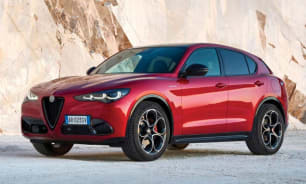Inside, the Tonale feels relatively spacious for a small SUV, with possibly more places to put things than you might expect from a traditionally enthusiast-focused brand.
In both front and rear seats, no part of the body or console impedes on passenger space - though the door armrests feel like they're a little far to comfortably rest an elbow on - and nothing gets in the way when reaching controls or the centre console.
Ergonomically, everything falls well to hand and no far reaches are really required, though the cupholders in the centre are a little narrow for some relatively normal-sized cups or bottles, and have rubber grips inside that require a little extra pull to retrieve items from.
Other options for bottles include the door pockets, or for a small bottle even the centre console bin is quite deep (albeit narrow).
Smartphones, even fairly tall ones, will rest securely in the angled - a nice touch - wireless charging bay, though while having the phone in a position it won’t slide out from is a plus, angling a phone screen to be visible to the driver might be too tempting for some. It is, mercifully, a little obscured by the gear shifter.
On controls, the steering-wheel design hasn’t changed for more than half a decade which, honestly, is so, so fine. Really, Alfa’s steering wheel has few buttons including the engine start, a relatively timeless (read: simple) visual style, and a thin rim with moulded thumb rests that encourage 9-and-3 hand positions.
The buttons on the wheel are easy, clear, and feel nice, and controlling the driver display is relatively easy as there aren’t really sub-menus to get lost in.
The main multimedia screen is also relatively well laid out, marking a nice step up from previous Uconnect systems (Jeep and Fiat owners will also know), though the connectivity with wireless phone mirroring, Android Auto in my case, was a little laggy and dropped out occasionally, seemingly in the same spot on the same Melbourne CBD street during my commute each morning.
The downsides are relatively few on the practicality front, but there is another: the boot space in the hybrid suffers due to the battery space needed, so 500 litres for the non-plug-in Tonale variants is down to 385 litres for the PHEV.
That’s still less than an electric Volvo XC40 Recharge (claimed to be 418L), though fortunately it grows to a spacious 1430 with the seats folded down, and is accessible via an automatic electrically opening boot door.
Another important point, while we’re in the boot, is the lack of spare tyre. Instead, a repair kit is provided - something those who enjoy a road trip might lament.

